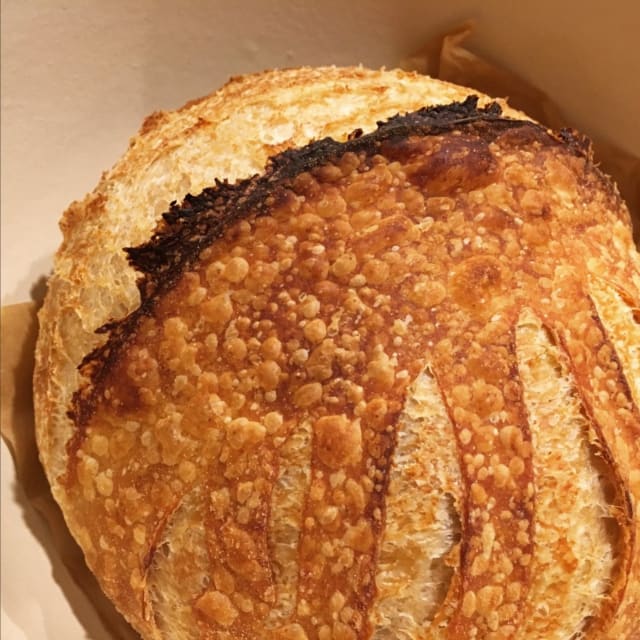Rustic Blonde

With a few little tweaks to the Basic Sourdough recipe, you can cook up this light, chewy, crusty loaf for yourself.
I let the levain ferment for about four hours—only a little more than doubled. This is meant to be a nice light multi-purpose bread, so you’re not going for Maximum Funk™ on this one.
After a thirty minute autolyse, this one was machine-kneadable for me (your flour’s mileage may vary, of course). Add water and flour, mix, cover loosely, play Final Fantasy XIV for half an hour, add the levain and salt, and knead with a dough hook/spiral on low speed for about ten minutes. Let it rest for another ten minutes and then give it the ol’ windowpane test; knead for a minute or two more if needed. Ball it up, throw it in a bucket, and give it four hours out on the counter—then three days in the fridge for the bulk ferment.
Now, the key to that shatteringly crisp and blistered crust is two-fold: dusting with white rice flour (Bob’s Red Mill sells it), and of course, steam. You’ll get two loaves out of the amounts listed above—I usually throw the second half back into the fridge for another day or two. So fresh out of the fridge: hack the dough in half, purse one half into a tight ball, dust it generously with rice flour and plop it into a round banneton. Remember that you can always brush off excess dusting flour before you throw them in the oven, but you can’t do much to un-stick a stuck loaf. Four hours out on the counter for the final proof; start preheating your oven to 500 around hour three, with your Dutch oven in already in there.
To keep from deflating my dough during the transfer I place a sheet of parchment on a peel, lay that over the top of the proofing basket, and flip the whole thing—otherwise you’re plopping the dough from the basket onto a peel or into the dutch oven, and you’re gonna lose some air. Slash the loaf on the peel.
To put it into the Dutch oven, I lift the parchment by the corners, which is... perhaps not the safest method, but here we are. Lower it in there, mist the crust with hot water, and cover. At this point I crack the lid of the Dutch oven and mist the inside again every few minutes—after about five minutes and a few spritzes, lower the oven temperature to 450 and set a timer for twenty minutes.
After your timer runs up, remove the cover; the crust will have a waxy, yellowed look to it. Bake, uncovered, for another twenty minutes.
Ingredients
Levain
-
25 G Mature Starter
-
100 G Water, (90°–100° f)
-
100 G Bread Flour
-
25 G Whole Wheat Flour
Final Dough
-
900 G Bread Flour
-
50 G Whole Wheat Flour
-
50 G White Rye Flour
-
700 G Water, (90°–100° f)
-
22 G Kosher Salt
Instructions
Instructions Levain
Add mature starter and lukewarm water to a mixing bowl; swirl until water is cloudy and starter is mostly dispersed. Mix in white and wheat flour until fully incorporated.
Let stand at room temperature, loosely covered, for four to nine hours.
Instructions Final Dough
Combine water and bread, whole wheat, and rye flour until fully incorporated.
Let stand at room temperature for thirty minutes to autolyse.
Add both salt and levain, and machine knead on low speed for ten minutes. Allow dough to rest for at least fifteen minutes before performing a windowpane test. If dough tears easily: continue kneading for a few minutes more, allow to rest, and perform the test again.
Remove dough to a lightly oiled bowl or proofing bucket and either mist the dough lightly with spray oil or roll it around the container to prevent drying. Seal the bowl/container with plastic wrap and let rest at room temperature for two hours. Move container to refrigerator and allow to ferment at least overnight, and up to four days.
On baking day, shape dough and dust with white rice flour, or place in round, well-dusted proofing baskets. Allow to proof at room temperature for at least four hours.
Place covered Dutch oven into oven and preheat to 500°f while dough continues to prove.
Transfer shaped loaf to a square of parchment paper, and slash. Carefully move dough to Dutch oven and mist with hot water. Return cover to Dutch oven and return to oven for twenty five minutes.
Carefully remove lid from Dutch oven and continue to bake for twenty five minutes, or until the center of the loaf reads 210°f on an instant-read thermometer
Allow bread to rest for at least half an hour before cutting.